- within Environment topic(s)
- in European Union
- in European Union
- in European Union
- in European Union
- in European Union
- with readers working within the Law Firm industries
- within Environment, Antitrust/Competition Law and Privacy topic(s)
1. Introduction
The United Nations Convention on Biological Diversity (CBD), also known colloquially as the Biodiversity Convention, is the multilateral agreement that was opened for signing at the 1992 Earth Summit in Rio de Janeiro. It is an essential document for sustainable development. It falls within the purview of the UNEP. 196 countries have ratified the Convention on Biological Diversity (CBD) as of this moment.
The Convention on Biological Diversity, which was signed by 150 country leaders at the Rio Earth Summit in 1992, is committed to encouraging sustainable development. The Convention recognises that biological variety is about more than plants, animals, and microorganisms and their ecosystems; it is about humans and our need for food security, medicines, clean air and water, shelter, and a healthy environment to live in.
1.1 Primary Goals of the Convention on Biological Diversity
The primary goals of CBD are mentioned as below:
- To encourage sustainable utilisation of its components
- To encourage equitable utilisation of its resources, and
- To make protection of biological diversity a priority
|
"Biodiversity is the variation among living organisms from different sources including terrestrial, marine and desert ecosystems, and the ecological complexes of which they are a part"1 |
1.2 Summary of key aspects of The Convention 2
The text of the Biodiversity Convention contains 42 Articles and 3 Annexes. Following is the summary of important articles:
Article 4 of the Convention addresses the Convention's Jurisdictional Scope, which extends the Convention's provisions to the national jurisdictions of the contracting parties.
Article 6 discusses the broad measures for conservation and sustainable use through which contracting parties are required to adopt national strategies and combine conservation and sustainable use of biological diversity.
Articles 8 and 9 discuss in-situ conservation and ex-situ conservation, respectively.
Article 13 of the Convention addresses public education and awareness through promotion, cooperation, and encouragement to comprehend the significance of biological variety conservation.
Article 17 stipulates that the parties shall encourage the interchange of information from all publicly accessible sources.
Directly or indirectly, the Biodiversity Convention attempts to encompass all potential realms. It addresses biotechnology and the distribution of its benefits under Article 19.
Article 29 discusses amendments to conventions or protocols and states that any contracting party may submit an amendment to a convention, while any party to a protocol may propose an amendment to that protocol.
Article 31 grants each contractual party one vote. It further stipulates that regional economic integration organisations can exercise their voting rights with the same number of votes as their member states, which are the contracting parties.
Article 26 discusses the settlement of conflicts through negotiation, and if the parties are unable to reach an agreement, they may seek mediation. During the process of ratifying, accepting, approving, or acceding to the convention, a state or regional economic integration organisation may declare its acceptance of any of the following methods of dispute settlement if it is unable to reach an agreement through negotiation or mediation:
- Arbitration
- The conflict is referred to the International Court of Justice
Article 32 discusses the link between the Protocols and the Convention, while Article 28 discusses the adoption of protocols.
Article 41 states that the Secretary-General of the United Nations shall serve as Depositary of this Convention and any additional protocols.
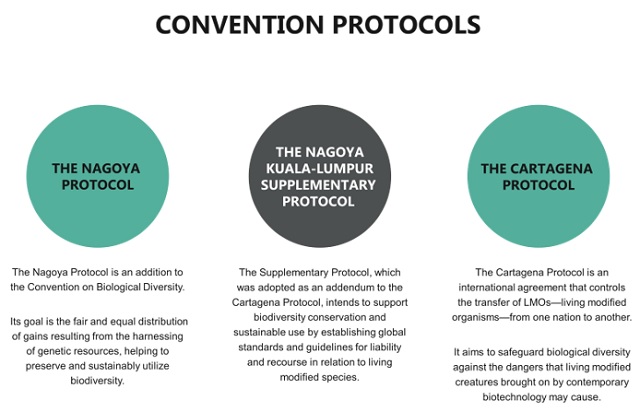
2 What is the Conference Of Parties (COP) ?
The Convention's Article 23 established the Conference of the Parties. It is the regulatory body of the Convention, and the choices it makes at its periodic sessions enhance the Convention's implementation.
Its first ordinary meeting took place in Nassau, Bahamas, from November 28 to December 9, 1994, with the theme "Guidance to the financial mechanism; Medium-term work programme."
The conference of parties has thus far convened fourteen ordinary meetings and one extraordinary meeting in two parts. Prior to the year 2000, the ordinary meetings were scheduled to take place; however, it was determined that they would be held every 2 years.
The SBSTTA and the SBI advise the conference of parties. The SBSTTA is constituted under Article 25 of the Convention. It is responsible for providing the conference of parties with suggestions on the scientific and technological aspects of the convention's implementation. The SBI was established by the conference of parties in order to review the implementation of the convention and identify strategic steps to develop and strengthen it.
The first portion of the 15th meeting of the COP was conducted in Kunming, China, from 11 to 15 October 2021. Part two of the same event was held in Montreal, Canada, in December 2022.
2.1 Thematic Programs
The Conference of the Parties has established a number of thematic programs that correspond to some of the world's most important biomes. These programs set a vision and guiding principles for future endeavours. In addition, they define essential factors, prospective outcomes, and a timetable for accomplishing these objectives. The conference of parties and the SBSTTA review these work programmes' implementation.
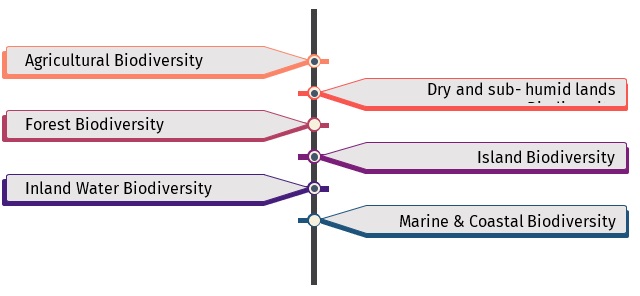
3 Plan Strategy For Biodiversity 2011-202 & The Aichi Targets
The 20 targets, commonly known as the Aichi Targets, are part of the strategic plan's shared vision, mission, strategic goals, and objectives. It acts as a flexible framework for setting regional and national goals. Additionally, it encourages the cogent and successful implementation of the Biodiversity Convention's goals.
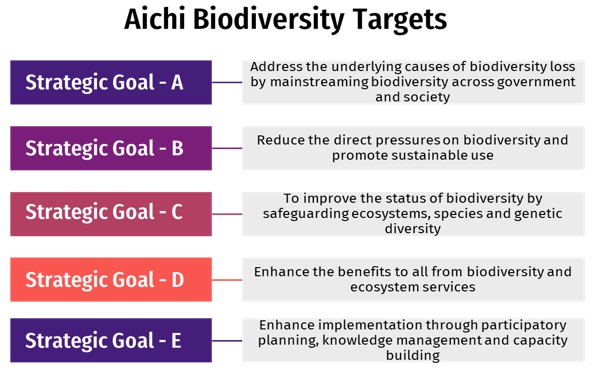
3.1 Global Biodiversity Framework POST 2020
The next global biodiversity framework is being prepared by the open-ended working group. It is anticipated that it will be accepted during the UN's second phase.
A set of guiding principles, an organisational structure, and a thorough consultation process are all included in the process that Parties used to create the post-2020 global biodiversity framework, which includes provisions for global, regional, and thematic consultation meetings. On July 12, 2021, the first version of the post-2020 global biodiversity framework was made public. The 2050 Vision for Biodiversity is reflected in the framework's four long-term objectives. There are 21 concrete goals that must be accomplished by the year 2030, following the draught The Convention on Biological Diversity's support mechanisms, such as the financial mechanism, and strategies for resource mobilisation, capacity-building and advancement, scientific and technological cooperation and technology transfer, knowledge management, as well as through pertinent mechanisms under other agreements and international processes, will be used to facilitate the implementation of the framework and the achievement of its goals and objectives.
CBD – EVENTS3
|
S. No. |
DATE |
NAME |
PARTIES |
BRIEF DESCRIPTION |
|
1. |
February 17, 2021 to February 26, 2021 |
Informal Session for the 24th Meeting of SBSTTA-24 of the CBD |
Over 2,000 delegates, including 1,200 from parties and non-parties and 800 from intergovernmental organisations, Major Groups, Indigenous peoples, and local communities (NGOs) |
HELD: Virtually No negotiations took place. The first topic considered was the creation of the post-2020 global biodiversity framework. Some of the other agenda items were: · Synthetic Biology; · Marine and Coastal Biodiversity, · Biodiversity and Agriculture; · Risk Assessment and Risk Management of Living Modified Organisms (LMOs); · Invasive Alien Species. |
|
2. |
March 08, 2021 to March 14, 2021 |
Informal Session for the 3rd Meeting of SBI-3 of the CBD |
Over 2,000 people from 130 parties, NGOs, and international organisations. |
Held: Virtually Focused On: · Cartagena Protocol on Biosafety Assessment and Review. · In the context of Article 4 of the Nagoya Protocol, International Access and Benefit Sharing Instruments; · Resource mobilization and financial mechanism; · Reporting, assessing and reviewing mechanisms for the implementation of policies; · Capacity building, cooperation, transfer of technology, knowledge management, and communication; · Mainstreaming of biodiversity; · Cross-cutting elements, as well as the GBF'S interconnections with all of the above; · Review of progress in the implementation of the Convention; · Under the Article 10 of the Nagoya Protocol, the creation of a global multilateral benefit-sharing mechanism; · An analysis of the Convention's and Protocols' effectiveness; · Matters concerning administration and budget. |
|
3. |
May 03, 2021 to June 09, 2021 |
24th Meeting of the SBSTTA-24 of the CBD |
Over 1400 delegates representing 127 parties, non-parties, intergovernmental organisations, major groups, indigenous people, local communities, and non-governmental organisations (NGOs). |
HELD: Virtually The informal meeting's views and submissions were taken into consideration and elaborated upon during the official first reading. The GBF, marine and coastal biodiversity, risk assessment, and synthetic biology contact groups were formed following the first reading, along with Friends of the Chair groups on new and emerging issues and the Chair group on invasive alien species. The synthetic biology contact group was also formed following the first reading. Using non-papers and conference room papers, these working groups convened remotely in between plenary sessions. A biodiversity and health contact group was also formed and will meet at the SBSTTA-24 conference when it is resumed in person. To ensure that the GBF's initial draught could be finished on time, topics directly linked to the GBF were given top priority. |
|
4. |
May 16, 2021 to June 13, 2021 |
Third Meeting of the SBI of the CBD |
Approximately 3000 delegates, comprising 128 parties and 190 observer groups. |
HELD: Virtually · Review of the Convention and the Strategic Plan for Biodiversity's 2011-2020 implementation progress; · Review of the efficacy of the Cartagena Protocol on Biosafety; · The post-2020 global biodiversity framework (GBF); · Resource mobilization and the financial mechanism; · capacity building, technical and scientific cooperation, technology transfer, knowledge management, and communication; · co-operation with other conventions and international organisations; · There should be a system in place to monitor and evaluate the implementation; · Review of the Convention and its protocols in terms of its efficiency; · Further strategic measures to promote implementation of biodiversity mainstreaming; · In accordance with Article 4.4 of the Nagoya Protocol, specific international access and benefit-sharing mechanisms; · The Nagoya Protocol's Article 10 establishes a global multilateral benefit-sharing framework; · Budgetary and administrative issues. |
|
5. |
August 23, 2021 to September 03, 2021 |
Third Meeting of the Open-ended Working Group on the Post-2020 GBF |
Total of 1680 participants including 141 parties, one non-party, and more than 200 observer organizations |
HELD: Virtually The First edition of GBF and Ad Hoc Technical Expert Group's findings on approaches to address different perspectives on benefit-sharing from digital sequencing information on genetic resources were discussed during the meeting. Working group approved the draft report including reports from five contact groups: i. Goals, milestones and overall structure; ii. Reducing threats for biodiversity; iii. Tools and solutions for implementation and biodiversity mainstreaming; iv. Nature's contributions to people; and v. Digital Sequence Information on genetic resources. |
|
6. |
October 11, 2021 to October 15, 2021 |
UN Biodiversity Conference (Part One) |
More than 1500 in-person & over 3000 virtual participants |
HELD: Kunming, China · Theme - Ecological Civilization · Kunming Declaration, which urged for immediate and comprehensive action to incorporate biodiversity issues in all sectors of the global economy; · Two days' round of high-level discussions showed fresh dedication and urgency among heads-of-state and government, environmental ministers, and other influential individuals. · Commitments by parties and organizations to step up efforts for biodiversity conservation; · Private sector participation, such as an open statement from CEOs of major corporations to international leaders advocating swift action; · Parties approved the interim budget for 2022 for the CBD and its protocols; · Several procedural issues were addressed. |
|
7. |
March 14, 2022 to March 29, 2022 |
Geneva Biodiversity Conference |
2000 onsite & online participants |
HELD: Geneva, Switzerland · Digital sequence information (DSI) and the intersessional work that goes along with it; · GBF aims and goals, as well as key indicators, received substantial participation from all parties, with parties taking the lead in formulating the framework; · the spirit of collegiality that prevailed despite diverging opinions and varying national priorities; · Public attention and increased engagement of rights-holders and stakeholders, crucial for a whole-of-society approach to biodiversity preservation. · SBSTTA-24 adopted 11 recommendations to be taken up by COP-15 · SBI-3 also focused on elements required for the GBF, and adopted 20 recommendations and decisions · The WG2020 met in contact groups and reported progress in plenaries |
|
8. |
June 21, 2022 to June 26, 2022 |
Fourth Meeting of the Open-ended Working Group on the Post-2020 Global Biodiversity Framework |
1300 people from 156 countries, 675 in person, and 253 organisations, 260 in person, 540 online. |
HELD: Nairobi, Kenya · Section C of the 2030 Agenda for Sustainable Development (Section C) was unanimously agreed upon; · consensus on Target 12 on green & blue spaces for urban areas · consensus on Target 19.2 on non-financial elements of resource mobilization · Sharing the benefits of DSI with genetic resources on a new route to be mapped out. |
4 CBD AND INDIA4
The Convention on Biological Diversity (CBD) required, as a first significant step, the development of the National Policy and Macro Level Action Strategy (1999). This strategy called for the consolidation of existing biodiversity conservation programmes as well as the initiation of new steps that were in line with the spirit of the Convention. This was followed by the execution of the NBSAP Project (2000-2004) which provided micro-level action plans appropriately combining crosscutting problems and livelihood security concerns.
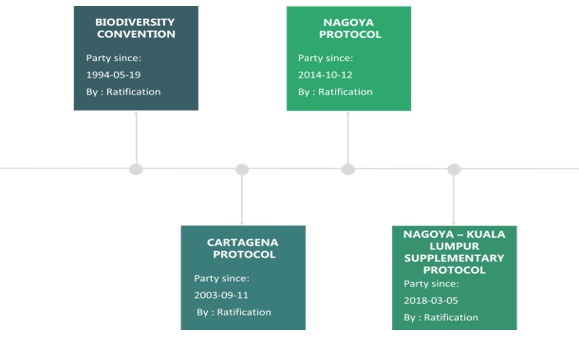
After the National Environment Policy (NEP) was approved in 2006, work began on the preparation of the National Biodiversity Action Plan by revising the document from 1999 to bring it into conformity with the NEP. The National Biodiversity Action Plan Project Report was one of the inputs that was used in this process. The National Biodiversity Action Plan (2008) defines targets, activities, and associated agencies for the achievement of the goals. It does this by drawing upon the primary principle in the NEP, which states that human beings are at the centre of concerns regarding sustainable development and that they are entitled to a healthy and productive life which is in harmony with nature. The National Biodiversity Action Plan (2008) was published in 2008.
After the Convention on Biological Diversity (CBD) was ratified and after extensive consultations, India also enforced the Biological Diversity Act in 2002 and notified the Rules in 2004. These actions were taken to give effect to the provisions of the CBD, including those relating to the third objective of the CBD, which is access and benefit sharing (ABS). The government of India was one of the very first in the world to implement legislation along these lines. According to the provisions for decentralised governance found in the Constitution, the Act is to be executed through a three-tiered institutional framework: the National Biodiversity Authority (NBA), the State Biodiversity Boards (SBBs), and Biodiversity Management Committees (BMCs) at the municipal level.
4.1 Alignment to CBD : Biological Diversity Act, 2002
India's attempt to realise the goals enshrined in the United Nations Convention on Biological Diversity (CBD) 1992, which recognises the sovereign power of the states to choose their own Biological Resources, gave birth to the Biological Diversity Act in the year 2002. This act was a result of India's attempt to realise the goals. The purpose of this Act is to ensure the preservation of biological resources, to manage their use in a manner that is compatible with long-term sustainability, and to enable local communities to participate in the fair and equitable distribution of benefits stemming from the utilisation and knowledge of biological resources. The Act forbids the following operations without the previous authorisation from the National Biodiversity Authority:
- Any individual or institution (either headquartered in India or not) accessing any biological resource occurring in India for its research or commercial exploitation.
- The dissemination of the findings of any research concerning any biological resources that are found in India or that are taken from India
- The assertion of any IP rights about any innovation based on the study done on the biological resources received from India.
The Act called for the establishment of a three-tiered regulatory system to govern access to biological resources:-
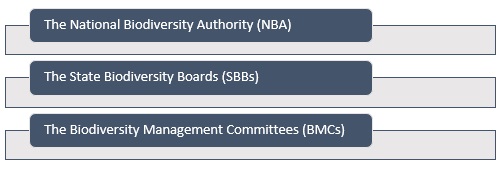
In order for these authorities to undertake any research project dealing with the natural resources of the nation, the Act grants them access to special funding in addition to their own allocated budget. It is responsible for overseeing any use of biological resources as well as the use of these resources in a sustainable manner.
Additionally, it is responsible for exercising control over financial investments as well as their return and the appropriate disposal of funds. In accordance with the Act, the Central Government, in cooperation with the NBA, is required to:
- Notify endangered species and either ban or control the collection, rehabilitation, and protection of those species.
- Designate institutions as repository for the various types of biological resources already in existence. The statute establishes all violations under it as cognizable and non-bailable. Any concerns connected to the decision of benefit sharing or decision of the National or State Board under this Act, must be brought to the National Green Tribunal.
4.1.1 Biological Diversity (Amendment) Bill, 2021

The Biological Diversity (Amendment) Bill, 20215, was tabled in Lok Sabha in December 2021 and afterwards referred to a Joint Parliamentary Committee.
The measure seeks to loosen key requirements in the Biological Diversity Act of 2002, which put a large "compliance burden" on Indian medicine practitioners, seed sector, industry, and researchers, making joint research and investments difficult.
- Simplify the Research Process: The revisions also simplify the Patenting Process for Indian Researchers in order to boost patenting. Regional patenting centres will be established around the country to facilitate this.
- Strengthening the Indian Medicine System: It aims to strengthen the "Indian system of medicine" by facilitating the fast-tracking of research, the patent application procedure, and the transfer of research results while utilizing the biological resources available in India. It aims to enable local populations to use resources, particularly those of therapeutic potential, such as seeds.
The Bill aims to encourage farmers to grow more therapeutic plants. These goals must be met without jeopardizing the goals of the United Nations Convention on Biological Diversity.
- Decriminalizing Specific Provisions: It tries to decriminalise specific provisions in the biological resource chain. These modifications were made in response to India's acceptance of the Nagoya Protocol in 2012.
- Allowing Foreign Investment: It also allows for international investment in biodiversity studies. This investment, however, will inevitably have to be done through Indian enterprises active in biodiversity research. Foreign entities must get permission from the National Biodiversity Authority.
- Exemption for AYUSH Practitioners: The Bill intends to exclude registered AYUSH medical practitioners and those accessing codified traditional knowledge, among others, from notifying State biodiversity boards before exploiting biological resources for specific reasons.
WAY FORWARD
The Convention on Biological Diversity (CBD) is one of the three conventions that emerged from the Rio Summit in 1992 (or the United Nations Conference on Environment and Development), and India is a signatory to the CBD. The primary goal of enacting the Biodiversity Act was to ensure the legal implementation of the provisions of the CBD. India is a signatory to the CBD. The biological diversity, which refers to the variety of flora and fauna in the nation as well as the knowledge of its uses, is sovereign property, which means that it belongs to India. This is one of the core tenets of the CBD and, consequently, the Biological Diversity Act, 2002. This is one of the fundamental principles of the CBD and also, in turn, the Biological Diversity Act, 2002.
The Biodiversity Act is responsible for enacting the Convention on Biological Diversity (CBD), which has three primary goals: to conserve biological diversity along with the traditional knowledge of its use; to promote and ensure the equitable sharing of any benefits that arise out of the use of this biological diversity and traditional knowledge, and to ensure the sustainable use of biological diversity.
The Act is the sole piece of legislation that exists to safeguard the natural resources of the country. It is a comprehensive piece of legislation in the sense that it safeguards India's natural resources, including its flora and wildlife as well as the indigenous knowledge linked with such things. It is intended for conservation, the usage that is sustainable, and the equal distribution of benefits.
On December 20, 2021, the Biodiversity Amendment Bill, 2021 was sent to a Joint Parliamentary Committee (JPC), which has been tasked with analysing the bill's provisions and presenting its findings and recommendations during the budget session of parliament scheduled for 2022. It has been brought to the attention of the JPC that the Ministry of the Environment has provided a partial answer to the multitude of issues that have surrounding the design and execution of the law. However, this also presents an opportunity for the JPC to carry out an in-depth examination of the long-standing gaps in India's BD regime and determine how those gaps need to be reconciled with international standards, particularly those that are outlined in the CBD and the agreements that it has established.
Equally as crucial is the recognition that the preservation of biodiversity is inextricably linked with other major global concerns over climate change, food security, and public health.
The Committee has the potential to do what the Ministry of the Environment has not been successful in accomplishing so far, namely, making the legislation on biodiversity a people's law and its conservation a popular political concern. The Biological Variety Act is a ground-breaking and forward-thinking piece of legislation that has the potential to favourably benefit the country's efforts to conserve its biological diversity.
Footnotes
1 https://www.cbd.int/convention/articles/?a=cbd-02
2 https://www.cbd.int/convention/text/
3 https://enb.iisd.org/negotiations/convention-biological-diversity-cbd
4 https://www.cbd.int/countries/?country=in
The content of this article is intended to provide a general guide to the subject matter. Specialist advice should be sought about your specific circumstances.



